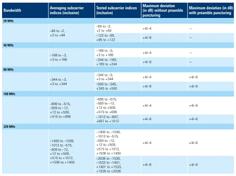Wi-Fi 7 (IEEE 802.11be) Transmit Spectral Mask Measurement
Advertisement
The IEEE 802.11be standard, more commonly known as Wi-Fi 7, brings a host of advanced features to the table, promising higher data rates and lower latency. A critical aspect of any wireless communication standard is the transmit spectral mask. This mask defines the allowable signal power levels across different frequencies, a measure crucial for minimizing interference and ensuring the efficient use of the radio spectrum. For Wi-Fi 7, the spectral mask requirements are even stricter than previous standards, a necessary adaptation to support wider channel bandwidths and higher-order modulation schemes.
Key Points of Wi-Fi 7 Spectral Mask
Here’s a breakdown of the key aspects of the Wi-Fi 7 spectral mask:
-
Wider Channel Bandwidths: Wi-Fi 7 supports channel bandwidths up to 320 MHz, and the spectral mask requirements are specifically defined for 20 MHz, 40 MHz, 80 MHz, 160 MHz, and 320 MHz channels. Wider channels demand more stringent spectral mask controls to effectively prevent interference.
-
Out-of-Band Emissions: The spectral mask dictates how much the signal power can “spill over” into adjacent channels. For Wi-Fi 7, the power must decrease rapidly outside the channel’s bandwidth to reduce interference with these adjacent channels.
-
Mask Specifications: The spectral mask is typically defined by a series of points on a frequency-power graph. These points represent:
-
Main Lobe: The main lobe represents the bulk of the signal power within the channel bandwidth.
-
Shoulders: The signal strength must drop sharply at the edges of the main lobe.
-
Adjacent and Non-Adjacent Channels: These define the power levels that must be maintained outside the main lobe to protect other channels from interference.
-
-
Tighter Requirements: Wi-Fi 7 enforces stricter mask requirements to support high-order modulation (up to 4096-QAM). This ensures that signal degradation and interference are minimized, allowing for reliable high-speed communication.
-
Frequency Stability: The spectral mask also includes requirements for the stability of the transmitted frequency. This ensures that the signal remains within the defined mask over time, even with temperature variations.
-
Compliance and Testing: Devices must undergo testing against the spectral mask to ensure compliance with the standard. This involves specific test equipment and defined conditions to measure the transmitted signal.
Example of Spectral Mask Levels for WiFi 7
The following figure shows a WiFi 7 transmit spectral mask for 320 MHz as defined in IEEE 802.11be.

As depicted, the power values for different spacing from the carrier frequency are:
- at the center frequency (i.e., ).
- at from the center.
- at from the center.
- at from the center.
These values ensure the signal is well-contained within the desired bandwidth and doesn’t significantly interfere with adjacent channels.
WiFi-7 Transmit Mask Values for all Channel Bandwidths
The following table shows spectral mask values for different channel bandwidths viz. 20 MHz, 40 MHz, 80 MHz, 160 MHz and 320 MHz.

Summary
Overall, the WiFi 7 spectral mask is designed to guarantee efficient use of the spectrum, minimize interference, and support the high data rates and reliability demanded by next-generation wireless applications.
Advertisement
 RF
RF



